Star Photography
Discussion
I've had a look at some of the pics and threads on here about astro photography, but still just can't seem to get it right.
Basically what I'm after is two different type of shots:
Star trails like this:
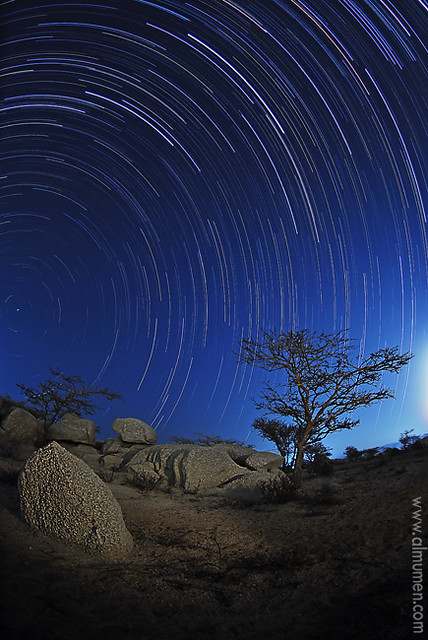
And just stars/milky way, like this:
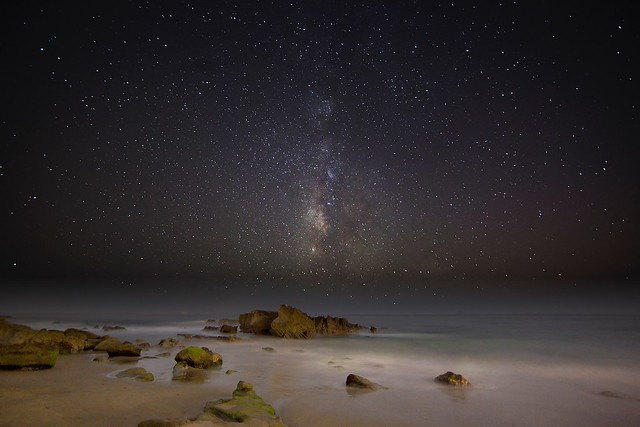
I see there is a lot of settings to consider, so some trial and error, but if anyone could answer these questions I would be grateful.
Trails:
1. For trails why do people use ISO's from 800-1600? Surely a lower ISO would enable a longer shutter speed, and a longer trail?
2. Can you stack the images in PS, or do you need dedicated software? If PS is OK, is there a tutorial or action that anyone on here has used?
3. I tried getting some trails last night, but the sky was coming out very bright, do you rally have to be miles from anywhere to try this? The thing is, I see a lot of star trail images with buildings and things in the foreground (which I would also like to do), how do you stop them from lighting up the rest of the frame on a long exposure?
4. Any help with ISO/shutter speed/aperture would be useful.
Static night sky:
1. I also tried this last night, high ISO, faster shutter etc. Got nothing. I think it was too bright. Has anyone has any success at these type of shots within say 50 miles of a city? I don't know how far out in the sticks I have to be to be able to see this?
2. Does a wide aperture and high ISO cause any issues? I imagine you have to get the focus just right otherwise everything will come out soft.
3. Anything else to help would be great!
Also for either shot, do I need to know moon cycles, light polution maps etc.? I live in Waterloo, Ontario BTW.
I have the time to experiment, but with two young toddlers and a demanding job, I can't be out all night every night, so anything that would speed up my learning would be greatly appreciated, thanks!

P.S. There is a building near me (in the city) that I would love to have as the foreground, but I fear the light polution might not make it possible.
Basically what I'm after is two different type of shots:
Star trails like this:

And just stars/milky way, like this:

I see there is a lot of settings to consider, so some trial and error, but if anyone could answer these questions I would be grateful.
Trails:
1. For trails why do people use ISO's from 800-1600? Surely a lower ISO would enable a longer shutter speed, and a longer trail?
2. Can you stack the images in PS, or do you need dedicated software? If PS is OK, is there a tutorial or action that anyone on here has used?
3. I tried getting some trails last night, but the sky was coming out very bright, do you rally have to be miles from anywhere to try this? The thing is, I see a lot of star trail images with buildings and things in the foreground (which I would also like to do), how do you stop them from lighting up the rest of the frame on a long exposure?
4. Any help with ISO/shutter speed/aperture would be useful.
Static night sky:
1. I also tried this last night, high ISO, faster shutter etc. Got nothing. I think it was too bright. Has anyone has any success at these type of shots within say 50 miles of a city? I don't know how far out in the sticks I have to be to be able to see this?
2. Does a wide aperture and high ISO cause any issues? I imagine you have to get the focus just right otherwise everything will come out soft.
3. Anything else to help would be great!
Also for either shot, do I need to know moon cycles, light polution maps etc.? I live in Waterloo, Ontario BTW.
I have the time to experiment, but with two young toddlers and a demanding job, I can't be out all night every night, so anything that would speed up my learning would be greatly appreciated, thanks!

P.S. There is a building near me (in the city) that I would love to have as the foreground, but I fear the light polution might not make it possible.
For star trails, I use startrails.de to stack the images. For this image, I took 30 second exposures at f2.8, ISO 200. A little experimentation is always useful though. There are about 90 stacked images used here.

Startrail 2 rebuild by julianhj, on Flickr

Startrail 2 rebuild by julianhj, on Flickr
Have a look at AWN's excellent tutorial on his blog, I found it really helpful for city stairtrails
http://longexposuretips.blogspot.com/
http://longexposuretips.blogspot.com/
Startrails.de is a very good piece of software to use in order to stack images.
For instance:
500 stacked images

500 stack Startrail by 14-7, on Flickr
200 stacked images
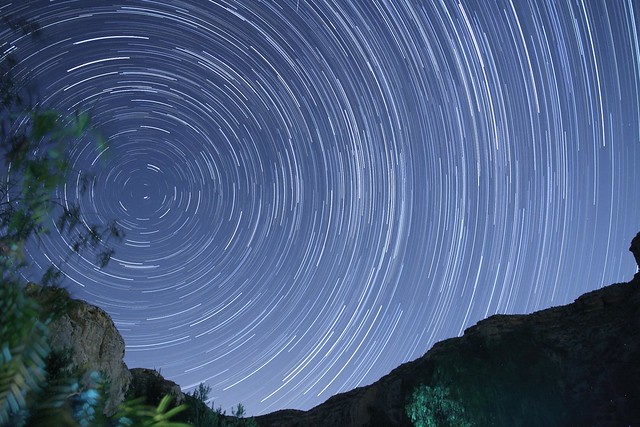
200 stack Startrail by 14-7, on Flickr
50 stacked images
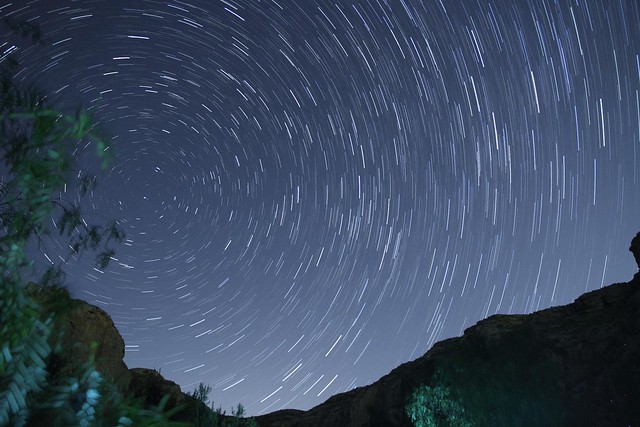
50 stack Startrail by 14-7, on Flickr
For a stactic shot how are you taking them?
The ones I used to create the stacks were about 20-25 seconds long from recollection using a high ISO and f3.5.
For instance:
500 stacked images

500 stack Startrail by 14-7, on Flickr
200 stacked images

200 stack Startrail by 14-7, on Flickr
50 stacked images

50 stack Startrail by 14-7, on Flickr
For a stactic shot how are you taking them?
The ones I used to create the stacks were about 20-25 seconds long from recollection using a high ISO and f3.5.
Thanks for the shout Iain
Each stop of iso lets in more starlight so people using wide angle lenses which are generally not renowned for their speed will commonly bump the iso to fill the frame with startrails. The more individual stars you're able to catch a trail from, the shorter you can run your exposure because there's fewer gaps. Pointing towards Polaris with a UWA you'd want 30-40 mins to begin to represent the circle of stars at, let's say, iso800 and f/4
On the other hand, for an uncomplicated and relatively cheap way to record the milky way you want somewhere super-dark so you can go to town on iso and aperture. People with a more scientific approach than I are generally united in the belief that ISO3200 f/2.8 for 30 seconds is your ideal approach to capture the MW. After 30 seconds on a UWA you can still give the appearance of stars looking like pinpricks rather than trails.
Posted from iPad, will try and back this up with some ex-planet-ary images (see what I did there) later.
Each stop of iso lets in more starlight so people using wide angle lenses which are generally not renowned for their speed will commonly bump the iso to fill the frame with startrails. The more individual stars you're able to catch a trail from, the shorter you can run your exposure because there's fewer gaps. Pointing towards Polaris with a UWA you'd want 30-40 mins to begin to represent the circle of stars at, let's say, iso800 and f/4
On the other hand, for an uncomplicated and relatively cheap way to record the milky way you want somewhere super-dark so you can go to town on iso and aperture. People with a more scientific approach than I are generally united in the belief that ISO3200 f/2.8 for 30 seconds is your ideal approach to capture the MW. After 30 seconds on a UWA you can still give the appearance of stars looking like pinpricks rather than trails.
Posted from iPad, will try and back this up with some ex-planet-ary images (see what I did there) later.
Bob_Defly said:
Trails:
1. For trails why do people use ISO's from 800-1600? Surely a lower ISO would enable a longer shutter speed, and a longer trail?
2. Can you stack the images in PS, or do you need dedicated software? If PS is OK, is there a tutorial or action that anyone on here has used?
3. I tried getting some trails last night, but the sky was coming out very bright, do you rally have to be miles from anywhere to try this? The thing is, I see a lot of star trail images with buildings and things in the foreground (which I would also like to do), how do you stop them from lighting up the rest of the frame on a long exposure?
4. Any help with ISO/shutter speed/aperture would be useful.
I used a series of 30 second exposures, just set up the camera on continous drive and let it go. So use the lowest ISO you can get it to expose correctly with for 30 seconds.1. For trails why do people use ISO's from 800-1600? Surely a lower ISO would enable a longer shutter speed, and a longer trail?
2. Can you stack the images in PS, or do you need dedicated software? If PS is OK, is there a tutorial or action that anyone on here has used?
3. I tried getting some trails last night, but the sky was coming out very bright, do you rally have to be miles from anywhere to try this? The thing is, I see a lot of star trail images with buildings and things in the foreground (which I would also like to do), how do you stop them from lighting up the rest of the frame on a long exposure?
4. Any help with ISO/shutter speed/aperture would be useful.
The Startrails.de software works well, just don't shoot in RAW like I did as it wants Jpegs.
You wil have to be in quite a dark place, the buildings may well be away from major towns.
In the shot below I was around 10 miles from a reasonable sized town (not a big town or city though), the orange glow is light polloution as it was taken at about midnight. The stars are not paticularly bright as it was a little cloudy.
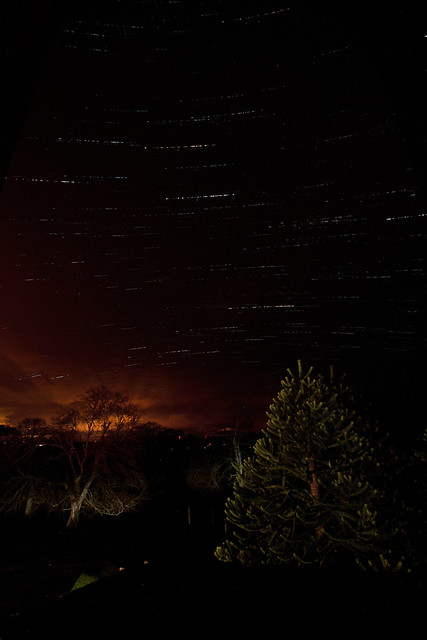
Startrails at pitodrie house by Brent Leport, on Flickr
As for the static shots, I've no idea! But it'll have to be properly dark and clear.
Right, got an actual computer in front of me that does actual copy and paste - so much easier for forum image links than the iPad.
2) You can stack in PS and there are actions for it (though I don't have first-hand experience). Lots of mention on here of startrails.exe freeware but if
you're not already using it just go straight for StarStaX. It's also free but it's so much faster than the startrails.exe program and is available in PC, Mac or Linux flavours. The StarStaX developer is also working on being able to stack from RAWs and the program will already output to tifs if desired.
3) You don't have to be miles from anywhere although being so does change the options you've got available. You just have to balance your exposure- which is *much* easier if you stack rather than try the single frame route. Moon does make a big difference though. Best to shoot around half moon (waxing or waning) as this doesn't materially affect the brightness yet does still offer some blue colour in the sky.
4) ISO200-1600 depending on aperture. I prefer wide aperture to high ISO so moved to primes and often shoot ISO200 f/2 30sec
Don't have to be miles from anywhere

Full moon not only brightens the sky and lights the foreground...
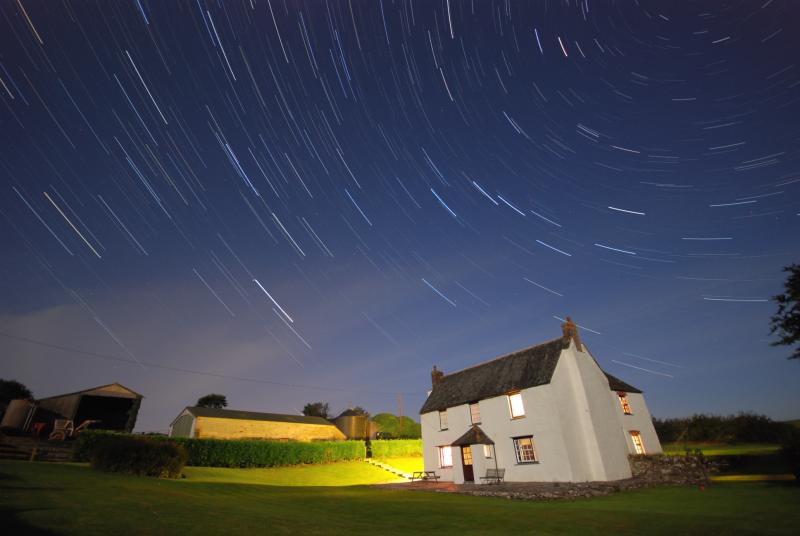
...also affects sky colour and WB appearance. (pretty much same settings but one week later with moon yet to rise)

Or, to look at it another way- some nearby streetlighting and full moon: ISO200 f/2.8 stacked 30sec exposures (each frame showed the sky/ boathouse this bright)

whereas with no moon and no ambient light at the same light sensitivity of ISO200 f/2.8 I needed to run for nearly half an hour to get this single frame. Crudely calculated, that's at least 6 stops' difference in the brightness of the sky from urban full moon to remote dark sky.

In my limited experience of MW shots, you want to be in the darkest corner possible not only for clarity but so you can see/ compose your photo. Despite high-ISO equivalence, our eyes don't cope so well with the dynamic range of looking at dark skies from a lit area.
HTH
Bob_Defly said:
Trails:
1. For trails why do people use ISO's from 800-1600? Surely a lower ISO would enable a longer shutter speed, and a longer trail?
2. Can you stack the images in PS, or do you need dedicated software? If PS is OK, is there a tutorial or action that anyone on here has used?
3. I tried getting some trails last night, but the sky was coming out very bright, do you rally have to be miles from anywhere to try this? The thing is, I see a lot of star trail images with buildings and things in the foreground (which I would also like to do), how do you stop them from lighting up the rest of the frame on a long exposure?
4. Any help with ISO/shutter speed/aperture would be useful.
1) Pretty much covered that in my previous response. 1. For trails why do people use ISO's from 800-1600? Surely a lower ISO would enable a longer shutter speed, and a longer trail?
2. Can you stack the images in PS, or do you need dedicated software? If PS is OK, is there a tutorial or action that anyone on here has used?
3. I tried getting some trails last night, but the sky was coming out very bright, do you rally have to be miles from anywhere to try this? The thing is, I see a lot of star trail images with buildings and things in the foreground (which I would also like to do), how do you stop them from lighting up the rest of the frame on a long exposure?
4. Any help with ISO/shutter speed/aperture would be useful.
2) You can stack in PS and there are actions for it (though I don't have first-hand experience). Lots of mention on here of startrails.exe freeware but if
you're not already using it just go straight for StarStaX. It's also free but it's so much faster than the startrails.exe program and is available in PC, Mac or Linux flavours. The StarStaX developer is also working on being able to stack from RAWs and the program will already output to tifs if desired.
3) You don't have to be miles from anywhere although being so does change the options you've got available. You just have to balance your exposure- which is *much* easier if you stack rather than try the single frame route. Moon does make a big difference though. Best to shoot around half moon (waxing or waning) as this doesn't materially affect the brightness yet does still offer some blue colour in the sky.
4) ISO200-1600 depending on aperture. I prefer wide aperture to high ISO so moved to primes and often shoot ISO200 f/2 30sec
Don't have to be miles from anywhere

Full moon not only brightens the sky and lights the foreground...

...also affects sky colour and WB appearance. (pretty much same settings but one week later with moon yet to rise)

Or, to look at it another way- some nearby streetlighting and full moon: ISO200 f/2.8 stacked 30sec exposures (each frame showed the sky/ boathouse this bright)

whereas with no moon and no ambient light at the same light sensitivity of ISO200 f/2.8 I needed to run for nearly half an hour to get this single frame. Crudely calculated, that's at least 6 stops' difference in the brightness of the sky from urban full moon to remote dark sky.

Bob_Defly said:
Static night sky:
1. I also tried this last night, high ISO, faster shutter etc. Got nothing. I think it was too bright. Has anyone has any success at these type of shots within say 50 miles of a city? I don't know how far out in the sticks I have to be to be able to see this?
2. Does a wide aperture and high ISO cause any issues? I imagine you have to get the focus just right otherwise everything will come out soft.
3. Anything else to help would be great!
Also for either shot, do I need to know moon cycles, light polution maps etc.? I live in Waterloo, Ontario BTW.
I have the time to experiment, but with two young toddlers and a demanding job, I can't be out all night every night, so anything that would speed up my learning would be greatly appreciated, thanks!

P.S. There is a building near me (in the city) that I would love to have as the foreground, but I fear the light polution might not make it possible.
You're going to struggle against light pollution for a milky way shot in an urban setting. Best to either wait for- or trigger- a widespread power cut. Several issues conspire against you- not just the required settings as mentioned in my previous post but also the required wide angle would make it unlikely to be able to exclude actual streetlamps and other light sources in your frame, and they are of course considerably brighter than the subjects they're illuminating. In most of my urban trails I'm capturing the effect of the light but not the light itself.1. I also tried this last night, high ISO, faster shutter etc. Got nothing. I think it was too bright. Has anyone has any success at these type of shots within say 50 miles of a city? I don't know how far out in the sticks I have to be to be able to see this?
2. Does a wide aperture and high ISO cause any issues? I imagine you have to get the focus just right otherwise everything will come out soft.
3. Anything else to help would be great!
Also for either shot, do I need to know moon cycles, light polution maps etc.? I live in Waterloo, Ontario BTW.
I have the time to experiment, but with two young toddlers and a demanding job, I can't be out all night every night, so anything that would speed up my learning would be greatly appreciated, thanks!

P.S. There is a building near me (in the city) that I would love to have as the foreground, but I fear the light polution might not make it possible.
In my limited experience of MW shots, you want to be in the darkest corner possible not only for clarity but so you can see/ compose your photo. Despite high-ISO equivalence, our eyes don't cope so well with the dynamic range of looking at dark skies from a lit area.
HTH
For wide-field astro I usually shoot around 20-30 seconds, anything from f/4-8, and adjust ISO. This was 16mm f/4 ISO4000 30s,
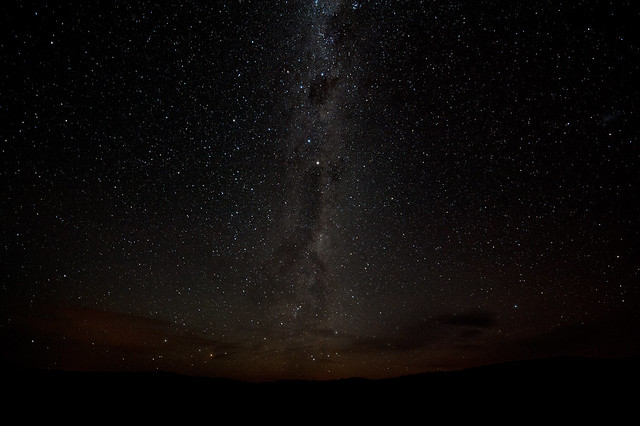
You might get an ok photo 50 miles from a city if you're pointing toward the darkest bit of sky but to get the shots you're after you'll need to travel to some dark places. Shouldn't be hard in your country
Sometimes you might want a (generally off-frame) moon to light foreground-ish subjects like mountains etc. I use astronomy software to see what's going on in the sky when I'll be going away somewhere dark.

You might get an ok photo 50 miles from a city if you're pointing toward the darkest bit of sky but to get the shots you're after you'll need to travel to some dark places. Shouldn't be hard in your country

Sometimes you might want a (generally off-frame) moon to light foreground-ish subjects like mountains etc. I use astronomy software to see what's going on in the sky when I'll be going away somewhere dark.
Thanks for all the tips, especially yours Andrew! I am off on holiday next week so will post the results back in a fortnight or so.
I think I have all I need for the static shot, for the trails, three more questions:
1. Should I shoot RAW or JPG, or both?
2. If shooting JPG what white balance should I use?
3. Is there a way to set the camera up (D300) to take shots continuously so that I don't have to keep clicking the remote for every exposure? What if the exposure is longer than 30 seconds?
Also, people (on flickr) seem to be able to get trails with 30 second exposures? When I tried it the other day to took me 10 minutes to get small trails. So does the stacking software combine many very small trails (i.e. virtually dots) into one longer trail?
I'll probably only get one night to try this, should I try many 30 second exposures or one really long one (1 hour or more)?
I think I have all I need for the static shot, for the trails, three more questions:
1. Should I shoot RAW or JPG, or both?
2. If shooting JPG what white balance should I use?
3. Is there a way to set the camera up (D300) to take shots continuously so that I don't have to keep clicking the remote for every exposure? What if the exposure is longer than 30 seconds?
Also, people (on flickr) seem to be able to get trails with 30 second exposures? When I tried it the other day to took me 10 minutes to get small trails. So does the stacking software combine many very small trails (i.e. virtually dots) into one longer trail?
I'll probably only get one night to try this, should I try many 30 second exposures or one really long one (1 hour or more)?
I'm heading to the complete middle of nowhere in Oregon on Saturday to capture what is probably the coolest natural phenomenon I've visited (so far) - Crater Lake, in the hope of getting (1) a nice golden hour sunset shot at the 6 mile wide caldera, and (2) to capture some cool star and milky way pics...
Baz, If you've not already seen it this is your benchmark photo for crater lake!
http://www.flickr.com/photos/bencanales/5725435948...
http://www.flickr.com/photos/bencanales/5725435948...
lol, Ben actually was my starting point for shooting night pics in Oregon last year, different level to mine 
ETA - that pic he took the night he got a b king from the park ranger for camping in his tent inside the restricted area at the rim edge
king from the park ranger for camping in his tent inside the restricted area at the rim edge 

ETA - that pic he took the night he got a b
 king from the park ranger for camping in his tent inside the restricted area at the rim edge
king from the park ranger for camping in his tent inside the restricted area at the rim edge 
Edited by baz7175 on Friday 22 July 06:56
Bob_Defly said:
1. Should I shoot RAW or JPG, or both?
2. If shooting JPG what white balance should I use?
If you have the ability to process it then I'd go RAW. 2. If shooting JPG what white balance should I use?
Bob_Defly said:
3. Is there a way to set the camera up (D300) to take shots continuously so that I don't have to keep clicking the remote for every exposure? What if the exposure is longer than 30 seconds?
Yes. Assuming it is the same as a D300S:- Shooting Menu
- Interval timer shooting
- Set it to 33 second intervals, and how many pictures you would like
- Set the camera to 30 second exposure on manual and adjust aperture and ISO to suit
Off you go!
You have to set the interval slightly longer than the exposure or it jumps 30 seconds, you may get away with 31 or 32 seconds but test it out before you set it going or you will get big gaps in your trails!
Bob_Defly said:
Also, people (on flickr) seem to be able to get trails with 30 second exposures? When I tried it the other day to took me 10 minutes to get small trails. So does the stacking software combine many very small trails (i.e. virtually dots) into one longer trail?
I'll probably only get one night to try this, should I try many 30 second exposures or one really long one (1 hour or more)?
I'd go with stacking many short 30 second trails as you can test the exposure of the stars and any foreground. One long exposure only give you one chance and no room for error!I'll probably only get one night to try this, should I try many 30 second exposures or one really long one (1 hour or more)?

North over the village by Suggs, on Flickr
gary71 said:
Bob_Defly said:
1. Should I shoot RAW or JPG, or both?
2. If shooting JPG what white balance should I use?
If you have the ability to process it then I'd go RAW. 2. If shooting JPG what white balance should I use?
Bob_Defly said:
3. Is there a way to set the camera up (D300) to take shots continuously so that I don't have to keep clicking the remote for every exposure? What if the exposure is longer than 30 seconds?
Yes. Assuming it is the same as a D300S:- Shooting Menu
- Interval timer shooting
- Set it to 33 second intervals, and how many pictures you would like
- Set the camera to 30 second exposure on manual and adjust aperture and ISO to suit
Off you go!
You have to set the interval slightly longer than the exposure or it jumps 30 seconds, you may get away with 31 or 32 seconds but test it out before you set it going or you will get big gaps in your trails!
Bob_Defly said:
Also, people (on flickr) seem to be able to get trails with 30 second exposures? When I tried it the other day to took me 10 minutes to get small trails. So does the stacking software combine many very small trails (i.e. virtually dots) into one longer trail?
I'll probably only get one night to try this, should I try many 30 second exposures or one really long one (1 hour or more)?
I'd go with stacking many short 30 second trails as you can test the exposure of the stars and any foreground. One long exposure only give you one chance and no room for error!I'll probably only get one night to try this, should I try many 30 second exposures or one really long one (1 hour or more)?

North over the village by Suggs, on Flickr
None of the free stacking programs process RAW files so unless you're a fan of batch processing, take time to get the camera set up and make sure JPG's on (I tend to shoot RAW+Fine Large JPGs unless I'm running out of space on the memory card). If it's super-dark, there's no reason you can't shoot a long frame for foreground/ ambient light and then stack a bunch of shorter exposures on top.
For blue sky WB will need to be between 4200k (out in the sticks with a lot of moonlight) and 2500k (if there's none or you're in the thick of light pollution).
The longer your focal length, the longer each star trail will appear for any given exposure duration. Also, the direction you're facing makes a difference to how long the trails appear. 30 seconds at 10mm facing north will give pinpricks; 30 seconds at 50mm (or longer) facing south will give noticeable trails.
40 mins N at 20mm
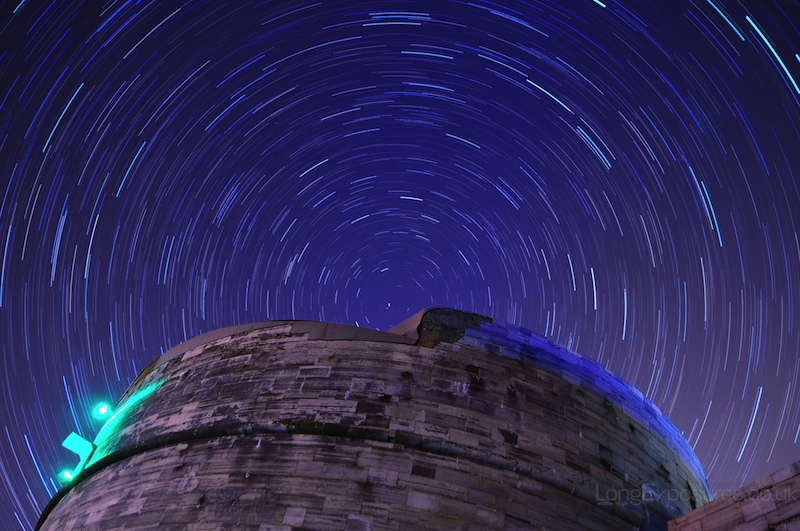
12 mins SW at 50mm
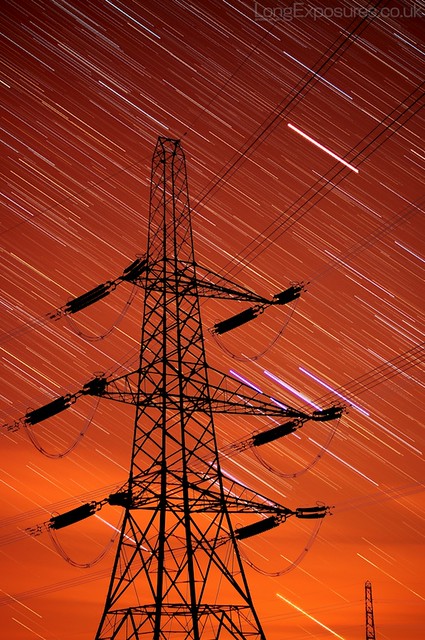
I'd recommend using a cable release over the inbuilt interval timer. I've never got my timer to work satisfactorily for an extended period; Dean also had problems with the D3 one night. Unintuitive and unreliable for long exposures, although great for daytime timelapses. Be aware whichever method you use, there's a limit to how many consecutive shutter releases the camera will do. I think it's adjustable on the timer but through an awkwardly different menu option. With the cable release locked, it's 100 (ie max 50 mins at 30 second exposures) but - if you release and then re-engage the cable release during the 90th~ frame the counter resets.
My plan was to stick around at the top of Bwlch Y Groes last night and get this shot without the light pollution, but it clouded over slightly and I didn't want to sit about for another hour waiting for it to be dark enough.
So in the end stopped on the way back (too close to civilisation!) and took this one.
Definitely something to try more of, maybe mid summer isn't the best time as it's so light so late.
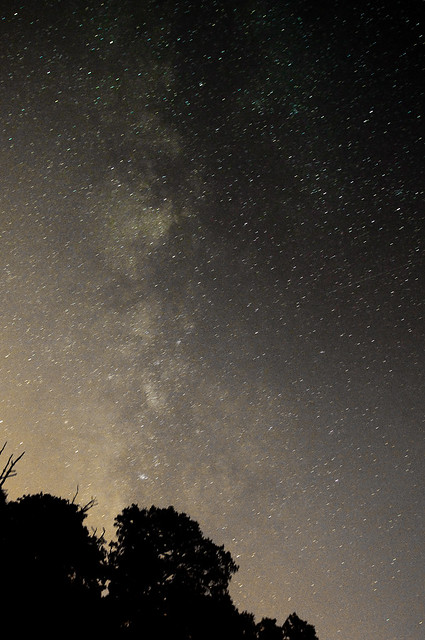
Milky Way by Suggs, on Flickr
So in the end stopped on the way back (too close to civilisation!) and took this one.
Definitely something to try more of, maybe mid summer isn't the best time as it's so light so late.

Milky Way by Suggs, on Flickr
I thought I'd give this a go last night as it was the first night without cloud for a while. The telescope was out already, but had misted up!
Anyway, this is just an experiment using a 50mm 1.8, so not as widefield as I would have liked. It's also pointing somewhere totally random in the Milky Way.....like I said, just an experiment with a bit of work in Gimp. Need to sort the hot pixels out, is it flats or dark frames that remove these??
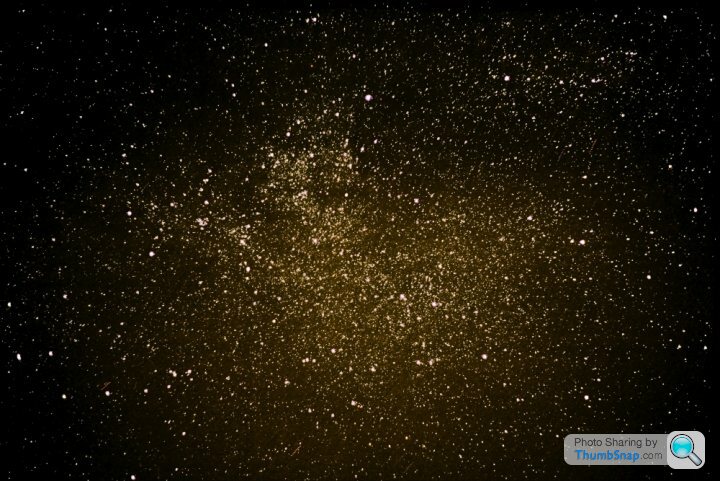
Anyway, this is just an experiment using a 50mm 1.8, so not as widefield as I would have liked. It's also pointing somewhere totally random in the Milky Way.....like I said, just an experiment with a bit of work in Gimp. Need to sort the hot pixels out, is it flats or dark frames that remove these??

Well I think it's fair to say 30 second intervals, 2 second gaps don't work...
Shame I'm home now and can't try again tonight

Kadekalesi Nightime by Martin_Bennett, on Flickr
Shame I'm home now and can't try again tonight


Kadekalesi Nightime by Martin_Bennett, on Flickr
Neilmac48 said:
Working in Malawi this year were light pollution does not exist can highly recommend it for astrophotography! Took this one last week my first attempt at a nightshot,Nikon D3s,Nikkor 24-70mm lens,f/2.8, ISO 102000,30 second unguided, with a bit of processing in lightroom 3.

Holy crap thats awesome
Gassing Station | Photography & Video | Top of Page | What's New | My Stuff



